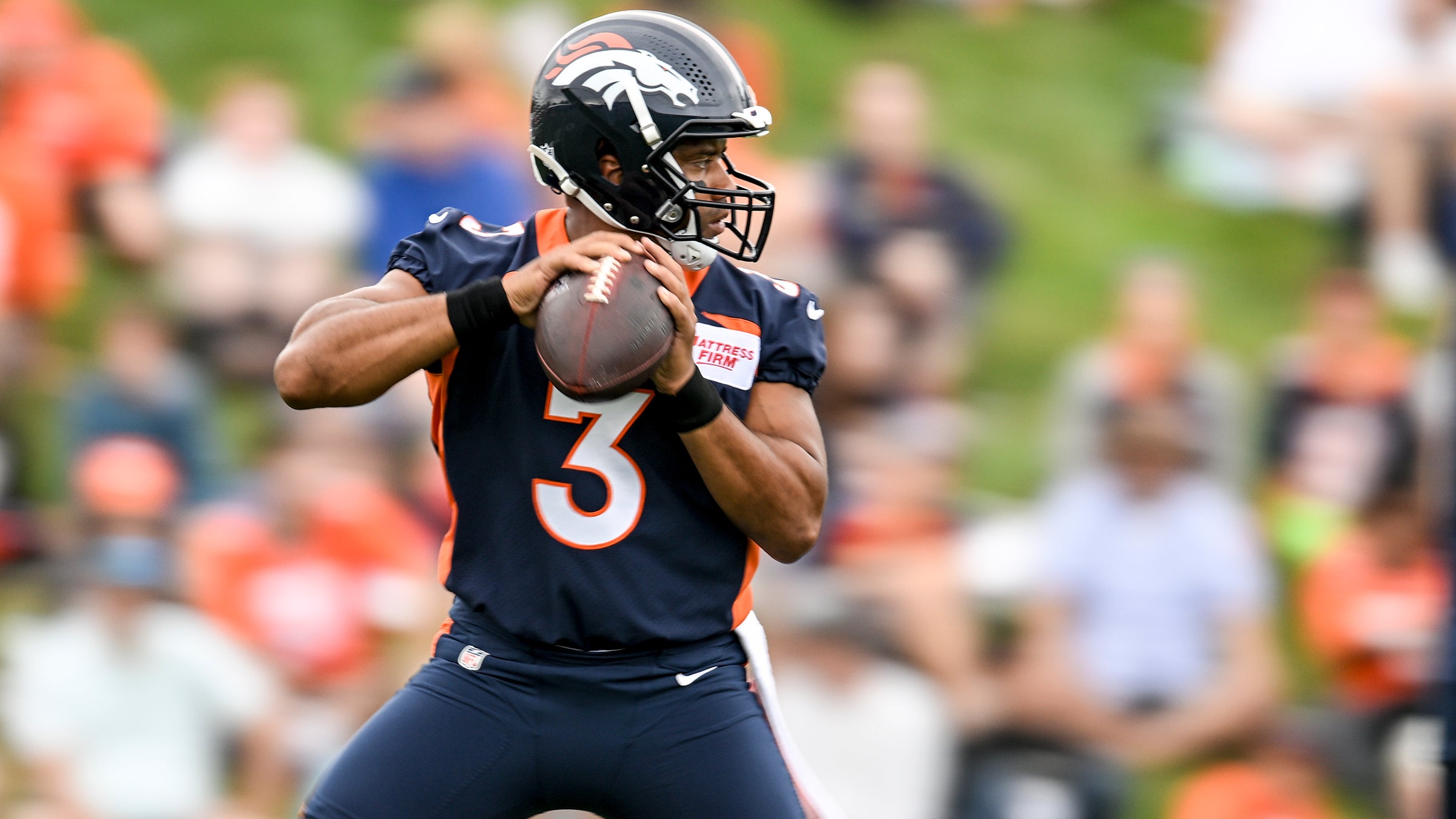National Football League training camps are underway, so sportsball media can finally start reporting important news, like what kind of vehicle star quarterback Russell Wilson drove to the first practice with his new team, the Denver Broncos.
Really: about the arrival of players at training camp, and one lead item was this Wilson , which contains a carefully constructed shot of the Broncos quarterback walking away from a massive pickup truck as he heads to work.
“Year 11,” he wrote, referencing his total number of seasons in the league. “Still got that new car smell!”
Uh, yeah, about that. The hulking truck—which —loomed over the quarterback, who, as detractors constantly note, is short by NFL standards at five foot eleven. @DangeRussWilson’s lifted Dodge Ram 2500 is a heavily modified urban assault vehicle, which includes a burly steel bullbar called the Stealth Intimidator. (Yours for only $5,800!) It’s more suited for the Ukrainian defense of Donbas than the mean streets of (checks notes) suburban Denver.
Looking at this bro-truck, I felt conflicted, my eager anticipation of Wilson’s ability to make the Broncos competitive again dampened by yet another reminder of the BS that surrounds this game, straining my fandom. I felt sadness that Wilson, who has been lauded for his philanthropic donations and work with charities, feels fine driving something so obscene. I felt disgust at the truck’s antisocial Punisher vibe. And I felt déjà vu—not from the NFL, but from my local trailheads and ski areas, where these elaborately outfitted beasts are increasingly common. I’ve long struggled to reconcile my love of football with the game’s ever-stronger representation of various skewed values of American culture. But when I look at my fellow outdoor enthusiasts these days—especially at what we drive—I wonder: are we so different?
I am an unlikely football fan. Although I grew up in the Denver ’burbs, I was not raised in a sports-crazed family. My dad, a University of Nebraska grad, was more apt to make the “” joke than to break down the triple option. Since football was not appointment viewing at home, it may be that my fandom started in the same place my journalism career did: by reading the sports section of the Denver Post, which I picked up off the driveway every morning.
NFL great John Elway is partly to blame. The Broncos, as Colorado’s first pro sports franchise, were always a big deal all over the state. But Elway transformed the team, starting in 1986 with : a desperate 98-yard, five-minute, fourth-quarter comeback against the Cleveland Browns that put the Broncos in their first Super Bowl in a decade. The Drive cemented Elway’s legendary status, even though it resulted in the first of three blowout losses in the title game. (Elway led the Broncos to Super Bowl titles in 1998 and 1999, so all was made right.)
Playing trumpet in the marching band at the University of Colorado—where the newly ascendant Buffaloes were NCAA Division I champions the year before I started school in 1991—was also a factor. Marching band is an underrated vehicle for instilling deeply held fandom. At CU, my, uh, “studies” coincided with the last of the school’s nationally relevant football teams, and from 1991 to 1994 I went to every home game, several road games, and three of CU’s four postseason bowls. (The athletic department, cheap bastards, refused to fly us to Hawaii for the 1993 Aloha Bowl.)
At the same time, I was developing a healthier, more wholesome side, falling in love with Boulder’s immense outdoor gifts: gorgeous, winding canyons for cycling; downhill, cross-county, and backcountry skiing nearby; endless running and hiking trails; and world-class rock and alpine climbing. Boulder in the 1990s wasn’t exactly undiscovered, but there were no timed-entry reservations at Brainard Lake, queues to climb the Bastille Crack, or pushy lift-line crowds on powder days. Once you got out of town on a road bike, traffic dropped to almost nothing. And no matter where you went, you didn’t see monstrosities like Wilson’s pickup.
To say the least, it hasn’t been easy to reconcile football fandom with my outdoor identity. When skier and cyclist friends learned I was so basic—such a normie!—the nose-wrinkling disdain was harsh enough that I ended up not mentioning it. At bike and outdoor industry trade shows, finding another football fan felt like entering a secret society. We’d bond over Xs and Os until others got confused or bored and drifted away from the conversation. I justified it all by simply accepting that football and the outdoors were separate parts of my life: a Venn diagram with circles that overlapped only by a sliver. Basic? Hardly, I told myself. I contain multitudes, brah.
And yet, over the years, my football faith has faced an increasing number of tests, and it is wavering. One inescapable problem—for me the most difficult—is the growing awareness of the game’s dreadful physical toll, especially the awful revelations about chronic traumatic encephalopathy (CTE) . No advance in helmet technology or tackling technique is likely to solve CTE; the risk is built into the game as it’s currently played.
Then there’s the greed: owners extorting new stadiums from fan bases by threatening to move teams to new cities, and —three times now in the case of the Raiders. Before the Broncos were sold this summer for a record $4.65 billion to an ownership group led by Walmart heir Rob Walton, that Walton wants to build a new stadium, possibly with some degree of public funding, to replace Empower Field at Mile High, which opened recently enough that it can’t legally drink yet.
Owners aren’t the only people who behave badly. In any subset of humanity, you’ll find grifters, narcissistic man-children, and other lowlifes. But football is excessive even in the world of pro sports, whether it’s cultures of sexual abuse and their or just the regular drumbeat of player arrests. And, of course, the wealthy and well-connected live by different laws than the rest of us, so this behavior is often coddled and excused. Exhibit A: Cleveland Browns quarterback Deshaun Watson getting after 24 civil lawsuits were filed against him for sexual assault—23 of which he settled out of court—neatly commodifying that each woman he was accused of assaulting was worth one 15-minute quarter of forced sideline time.
Today I watch football with an increasingly guilty conscience. I love the speed and athleticism, the strategic chess match of in-game adjustments. But every player carted off on a backboard, every revelation of cynical profiteering (using or ), and every half-assed, belated response to social justice issues cools my interest more. So I should spend those gorgeous fall weekends outside, not sports-yelling at a TV, right?
Ah, yes, outside. Where our collective addiction to has me wondering how many more ski seasons we have left, how many trails we’ll lose to wildfire. Where—like some animal adapting to human encroachment on its habitat—I’ve made profound changes in my road riding habits to minimize my interactions with distracted drivers in big Russmobiles. I’ve found positive ways to cope with the crowds, but it’s not always easy. The pandemic and the resulting outdoor land rush took behavior trends that had been simmering for years to full boil. More and more, we see entitled jerks about regulations, riding off-trail rather than stopping their shred sled for a moment to yield to others, and generally .
Which brings me back to Russ and his monster truck.
This thing is an outdoor bro’s ideal overlanding rig, and vehicles like it have become distressingly popular on the Front Range. You know the species. It starts with a pickup, most often a Tacoma but often something even bigger, like Russ’s Ram. Add a lift kit, oversized tires with meaty tread, and an obligatory bed-rack system with a rooftop tent. Finally, accessorize with : light bars, skid plates, traction boards, spare gas cans, and one of those burly bullbars, which are more useful for inflicting damage on whatever they hit than protecting the vehicles they’re on.
And that’s what bums me out, because as much as these trucks seem perfect for outdoor adventures, they’re overkill for hauling a bike to the trailhead, navigating I-70 to Summit County ski areas, or basically doing anything short of a major off-road expedition. Judging by the fact that I rarely see these rigs with a scratch or any real dirt on them, most of their owners probably think Pearl Pass is just another outdoor clothing store on Boulder’s pedestrian mall. Like an undersized QB on a new team, the primary purpose of big trucks among the outdoor crowd seems to be to cosplay toughness. But that image comes at a cost: driving a planet-burning, pedestrian-maiming Transformer that is one TIG welder away from . (“Do not, my friends, become addicted to low-carbon transport!”)
It doesn’t have to be this way. While ostentatious wealth-signaling is definitely in our society, there are any number of pro athletes whose vehicle choice is less aggro. Running back Alfred Morris’s . For years, NBA superstar Kawhi Leonard ran with a 1997 Chevy Tahoe. John Urschel, who started studying full-time for a PhD in mathematics at MIT while playing offensive line for Baltimore, drove a 2013 Nissan Versa hatchback. And speaking of big men in tiny cars, Shaquille O’Neal—seven foot one, 325—. Still others—Morris, Lebron James, wide receiver Juju Smith-Schuster—sometimes commute by bike, not car.
While Wilson has a rep in the game as something of a diva—and I wouldn’t take from him—he’s also known as a generally decent person: he’s , outspoken on social justice, and committed to sustained philanthropy and community outreach, efforts that, in Seattle, helped win him the NFL’s Walter Payton Man of the Year award. Examples matter, and Russ could set one.
Already, the fan/media honeymoon for Wilson . Within weeks he will be judged by his win-loss ratio, fated to face the same comparisons as the 11 other unfortunates who have stood behind center since former Broncos QB Peyton Manning rode off into the sunset in 2016. If Denver’s playoff drought extends to a seventh consecutive season, Wilson might soon be looking for a new set of license plates for that rig.
Maybe that’s a good thing for me. I’ve been more of an NBA fan the past few years anyway, watching two-time MVP Nikola Jokic—who Denverites half-seriously say is the best quarterback in the city—whip precise full-court passes. Maybe, instead of bowls and playoffs, I’ll spend more time playing in the dwindling snowpack of our backyard ski bowls. I’ll swap fall SEC Saturdays for riding high mountain trails over a golden carpet of aspen leaves. And in place of Sunday Night Football, I’ll finally get through that stack of books I bought with the best of intentions.
Should I read Barry Lopez’s or watch Wilson get blindside pancaked because overpriced left tackle Garett Holds—sorry: Garett Bolles—missed another B-gap blitz? Easy choice. I’ll still have to contend with the outdoor truck bros. But the thing about slowly, quietly exploring the outdoors is I know the tucked-away powder stashes they blast by, the winding singletrack trails that are a little too narrow for the handlebars on their enduro machines, and the trailhead parking spaces that are just big enough for a Subaru.


